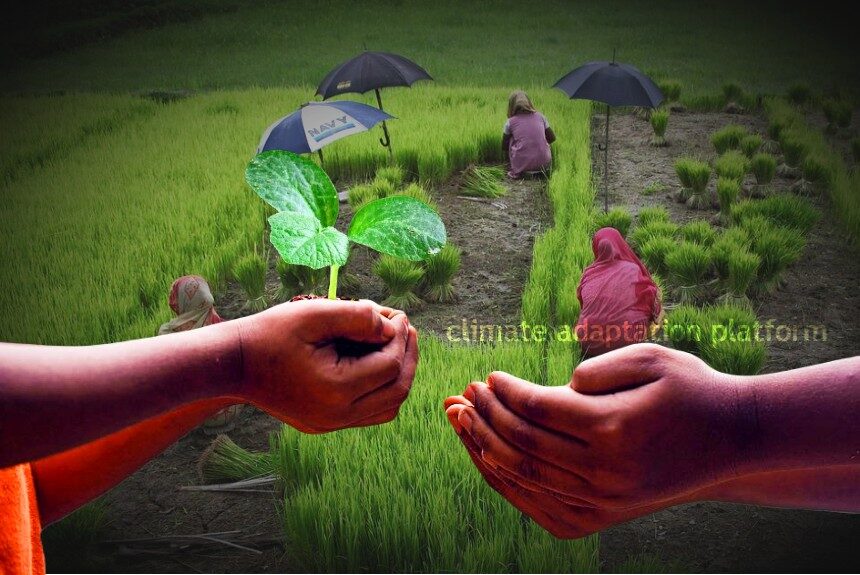Bangladesh is highly vulnerable to climate change due to its geographic location and topography. As a delta with low elevation – half of its land is 6 meters below mean sea levels, it is prone to floods and saltwater intrusion affecting its crops. Its funnel-shaped southern coast is prone to cyclones, storm surges, and sea-level rise (Bangladesh Climate, 2021).
These natural and climate change hazards impact agriculture in the country and its ability to produce the food needed by its growing population.
According to The Business Standard article, “Addressing food security and climate change through regenerative agriculture,” to help Bangladesh address food security and climate change risks, the practice of regenerative agriculture is the solution.
The article says:
- Regenerative agriculture is the most “viable, holistic, and sustainable” to ensure food security for Bangladesh’s growing population.
- “Regenerative agriculture is a farming system that attempts to conserve soil and contribute to multiple provisioning, regulating and supporting services of the ecosystem. And it aims to enhance the environmental, social and economic sustainability of food production. Some practices included in regenerative agriculture are diverse crop rotation, no-till/ direct seeding, cover cropping, compost/ manure application, livestock integration, and agroforestry.”
- “Regenerative agriculture can also be considered a Nature-based Solution (NbS). The International Union for Conservation of Nature (IUCN) defines NbS as “actions to protect, sustainably manage, and restore natural or modified ecosystems that address societal challenges effectively and adaptively, simultaneously providing human well-being and biodiversity benefits.”
- While Bangladeshis have been practising many NbS like swamp forest restoration, coastal afforestation, floating agriculture, slope vegetation, and many others, only regenerative agriculture improves soil health, which helps it store more carbon to mitigate the effects of climate change, the article says.
- The benefits of regenerative agriculture, according to the article, include: improving soil properties by decreasing soil compaction and stability and helping it retain vital chemical soil components like nitrogen, phosphorous, sodium, potassium, and magnesium, boosting plant growth and food production.
See the link provided in the “Source” section below to read the full article.
A study by the Environmental Studies Program from the University of Colorado Boulder, “What Is Regenerative Agriculture? A Review of Scholar and Practitioner Definitions Based on Processes and Outcomes”, answers the research question: How have different scholars and practitioners defined regenerative agriculture through a review of 229 journal articles and 25 practitioner websites to characterize the term “regenerative agriculture”?
The paper finds that there were many definitions and descriptions of regenerative agriculture in usage, and based on processes (e.g., use of cover crops, the integration of livestock, and reducing or eliminating tillage), outcomes (e.g., to improve soil health, to sequester carbon, and to increase biodiversity), or combinations of the two.
Another multi-intuitional study published in Frontiers, “A Study of Regenerative Farming Practices and Sustainable Coffee of Ethnic Minorities Farmers in the Central Highlands of Vietnam,” examined regenerative farming practices and sustainable coffee in a small ethnic minority village in Lâm Ðồng province.
The study mentions the following:
- Comparing the soil samples from the regenerative shade-grown coffee farm and two conventional sun-grown coffee farms, study findings “revealed that the soil of the regenerative farm, enriched with organic manure, is comparable to, or healthier than, the soil on the conventional farms enriched with chemical fertilizers.”
- “The results indicate that regenerative farming practices promote biodiversity; however, they also maintain microclimates that promote the growth of Roya fungus, which can decrease coffee yields.”
- “The economic analysis of farm costs and net returns found that regenerative farming practices decrease external inputs through a system of crop diversification and integrated livestock production that improves productivity and economic performance while preserving the ecological and environmental integrity of the landscape.”
The study concludes that “Regenerative agriculture is an important step toward climate change adaptation and mitigation; however, for the farm communities in the Central Highlands to make the transition to regenerative agriculture, this method’s success factors and benefits must be demonstrated to the coffee farmers.”
On May 19, 2021, the United States Agency for International Development (USAID), Green Invest Asia, and the Global Impact Investing Network (GIIN) hosted an online meeting with global agriculture and finance experts to discuss regenerative agriculture.
Given consumer trends, increasing demand for agriculture commodities worldwide, and limited cultivable land, the practice has attracted growing interest as a climate investment opportunity.
According to USAID, “The planet’s agricultural land has become so depleted that the United Nations predicts there are only about 60 growing seasons left until the world’s soil can no longer grow crops.
Regenerative farming aims to restore degraded soil, capture more carbon dioxide, and reverse climate change impacts while improving the ecosystem to make it more sustainable. Practices include minimizing soil disturbance from tilling and chemical inputs, increasing biodiversity, and covering the soil.”
Watch the webinar below:
Source:
Bangladesh Climate and Disaster Risk Atlas: Exposures, Vulnerabilities, and Risks – Volume II. (2021 December). Reliefweb. Retrieved from https://reliefweb.int/report/bangladesh/bangladesh-climate-and-disaster-risk-atlas-exposures-vulnerabilities-and-risks#
Bodrud-doza, Md. & Khan, S. (2022, April 24). Addressing food security and climate change through regenerative agriculture. The Business Standard. Retrieved from https://www.tbsnews.net/thoughts/addressing-food-security-and-climate-change-through-regenerative-agriculture-408578
Newton, P., Citiva, N., Frankel-Goldwater, L., Bartel, K., & Johns, C. (2020, October 26). What Is Regenerative Agriculture? A Review of Scholar and Practitioner Definitions Based on Processes and Outcomes. Frontiers in Sustainable Food Systems. Retrieved from https://www.frontiersin.org/articles/10.3389/fsufs.2020.577723/full
Le, Q.V., Cowal, S., Jovanovic, G. & Le, D.T. (2021, October 8). A Study of Regenerative Farming Practices and Sustainable Coffee of Ethnic Minorities Farmers in the Central Highlands of Vietnam. Frontiers in Sustainable Food Systems. Retrieved from https://www.frontiersin.org/articles/10.3389/fsufs.2021.712733/full
USAID Convenes Industry Brainstorm on Regenerative Agriculture. (2021 May 21). USAID. Retrieved from https://greeninvestasia.com/usaid-convenes-industry-brainstorm-on-regenerative-agriculture/



Leave a Reply